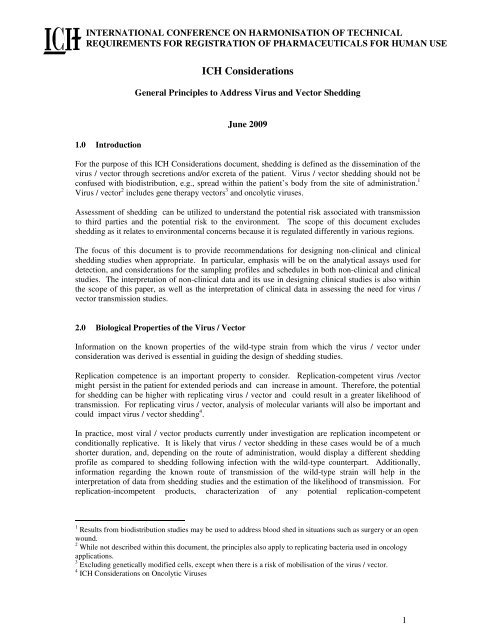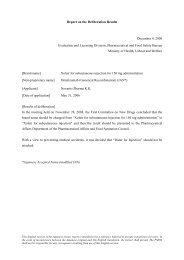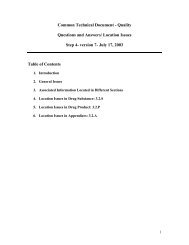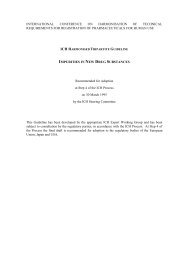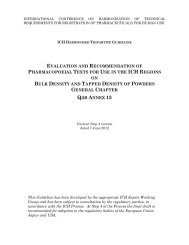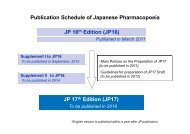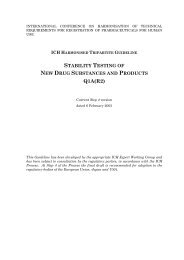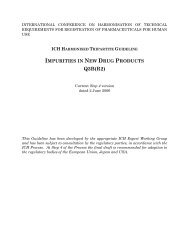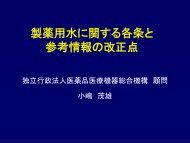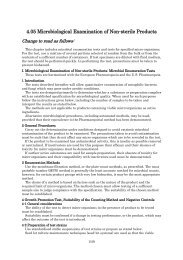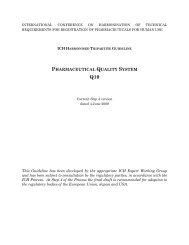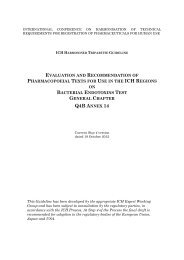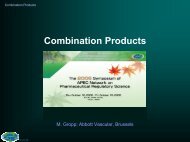General Principles to Address Virus and Vector Shedding - ICH
General Principles to Address Virus and Vector Shedding - ICH
General Principles to Address Virus and Vector Shedding - ICH
Create successful ePaper yourself
Turn your PDF publications into a flip-book with our unique Google optimized e-Paper software.
4.0 Non-Clinical ConsiderationsNon-clinical shedding studies help guide the design of clinical shedding studies. The aim of a nonclinicalshedding study is <strong>to</strong> determine the secretion / excretion profile of the virus / vec<strong>to</strong>r.Information collected from these non-clinical studies can then be used <strong>to</strong> estimate the likelihood <strong>and</strong>extent of shedding in humans. The non-clinical shedding study can be integrated in<strong>to</strong> the design ofother non-clinical studies (e.g., might not be a st<strong>and</strong>-alone study). It might be helpful <strong>to</strong> consider theresults of studies conducted with virus / vec<strong>to</strong>r products that display similar characteristics (e.g., thesame virus strain or a strain of the same virus / vec<strong>to</strong>r expressing a marker gene) prior <strong>to</strong> initiatingnon-clinical shedding studies.When designing <strong>and</strong> interpreting non-clinical shedding studies the following points should beconsidered:4.1 Animal SpeciesOne of the difficulties of investigating virus / vec<strong>to</strong>r products in non-clinical studies is the relevance ofthe animal species as a large number of virus / vec<strong>to</strong>r products under clinical evaluation are derivedfrom parental strains which do not readily infect <strong>and</strong> rarely replicate in non-human species. Thepermissiveness of the animal will clearly be important for interpreting data from non-clinical animalstudies. The expression <strong>and</strong> tissue distribution of viral recep<strong>to</strong>rs in a specific animal might affect theprofile of shedding of the virus / vec<strong>to</strong>r. Thus the profile of shedding might not directly correlate withthat in humans, as cellular <strong>and</strong> tissue sequestration could be different. The use of an animal model <strong>to</strong>mimic a disease condition can be helpful <strong>to</strong> best assess shedding. For example, the use of a tumourbearing model might be appropriate <strong>to</strong> support the replication of oncolytic viral products. The impac<strong>to</strong>f immunity <strong>to</strong> the virus / vec<strong>to</strong>r should be taken in<strong>to</strong> consideration as this can affect the rate of viral/ vec<strong>to</strong>r clearance <strong>and</strong> therefore shedding. See also sections 4.3 <strong>and</strong> 4.4 on sampling.4.2 Dose <strong>and</strong> Route of AdministrationWherever possible the dose <strong>and</strong> route of administration used in non-clinical shedding studies shouldreflect those intended for use in the clinical setting. The non-clinical pro<strong>to</strong>col should be designed formaximum exposure taking in<strong>to</strong> account the clinical route of administration <strong>and</strong> dose(s) selected. Forexample, the use of dose levels bracketing the anticipated clinical dose range could be considered forthe evaluation of virus / vec<strong>to</strong>r shedding in the non-clinical study.4.3 Sampling Frequency <strong>and</strong> Study DurationKnown biological properties of the wild-type strain can be used <strong>to</strong> guide the frequency of samplingafter virus / vec<strong>to</strong>r administration. In general, one might need <strong>to</strong> take samples more frequently in thefirst days following administration in order <strong>to</strong> detect a transient shedding profile. Practicalconsiderations should determine the number <strong>and</strong> frequency of samples, depending on the type ofexcreta or secreta.Several fac<strong>to</strong>rs should be considered when determining the duration of the study. These include thenatural course of infection of the parental virus, pre-existing immunity <strong>and</strong> the replicative capacity ofthe virus / vec<strong>to</strong>r under investigation.The course of a natural infection with the wild-type strain will give some indication of the expectedduration of shedding. It is of particular importance if the virus / vec<strong>to</strong>r under investigation isreplication-competent, as the duration should be sufficient <strong>to</strong> detect a possible secondary peak of virus/ vec<strong>to</strong>r suggestive of viral / vec<strong>to</strong>r replication. If the virus / vec<strong>to</strong>r persists for a long duration incertain tissues, i.e., kidney, lungs or the blood stream, it is recommended that the duration of sheddinganalysis should follow a similar time course. However if multiple consecutive negative samples areobserved it might be appropriate <strong>to</strong> shorten the study duration. It is important <strong>to</strong> note that for certainviral / vec<strong>to</strong>r products where latency or reactivation is a concern, negative tests performed in a prespecifiedtime period might not accurately capture virus / vec<strong>to</strong>r shed at later time points. It isrecognized that reactivation cannot always be modeled in non-clinical studies. Furthermore, immune3
e compromised, e.g., in the elderly or very young, <strong>and</strong> so clearance mechanisms might beinefficient. Thus the consequences of infection might be more significant in these individuals.It might be appropriate <strong>to</strong> instruct the patient <strong>and</strong> family members in ways <strong>to</strong> minimize the exposureof others. This could also include the advice <strong>to</strong> use specific sanitation measures.# # #6


